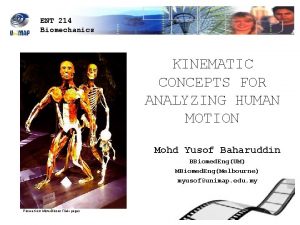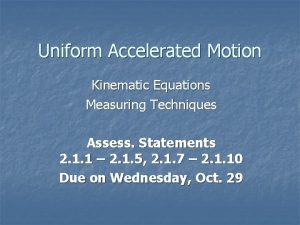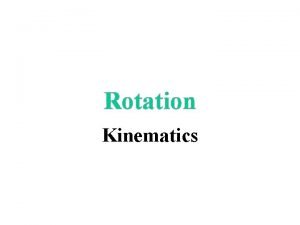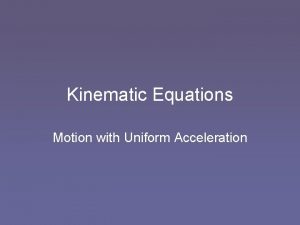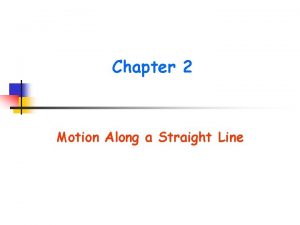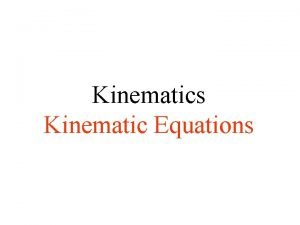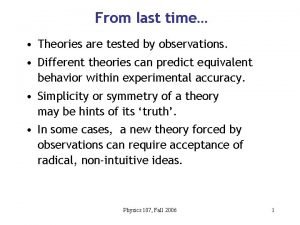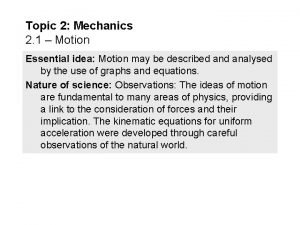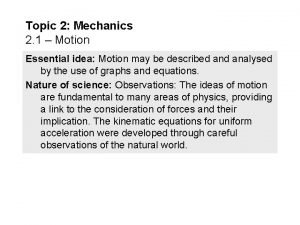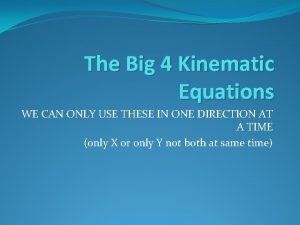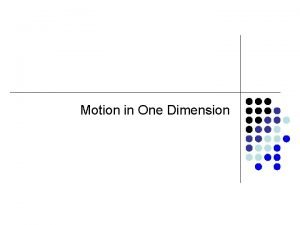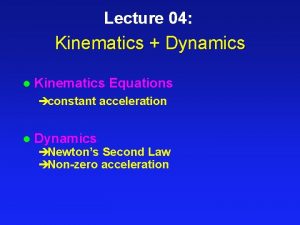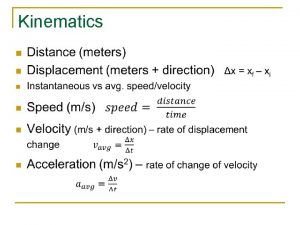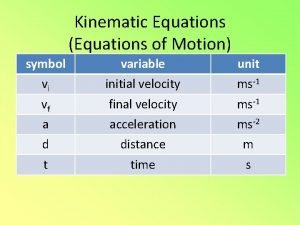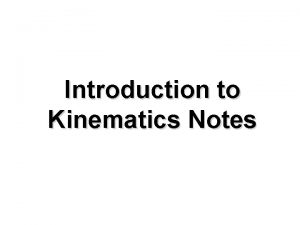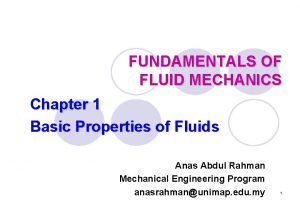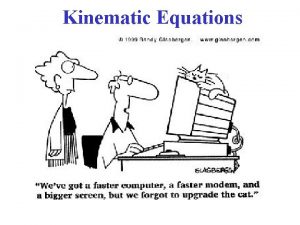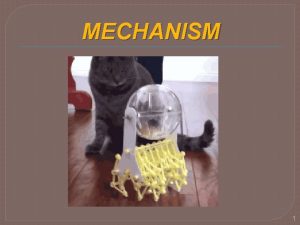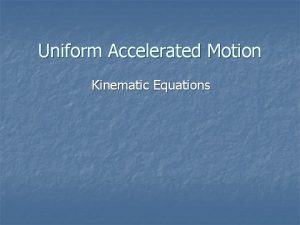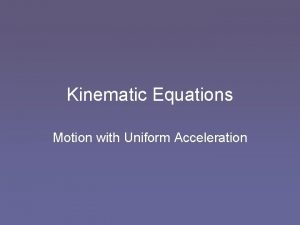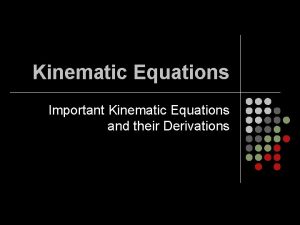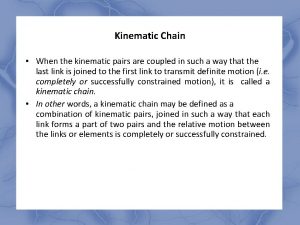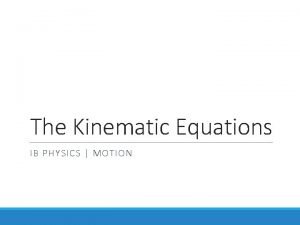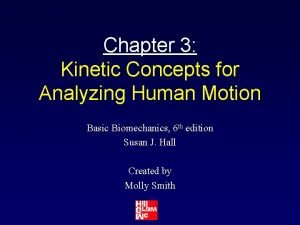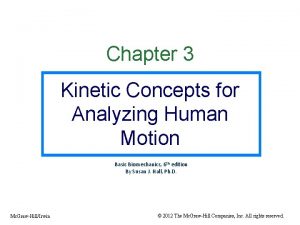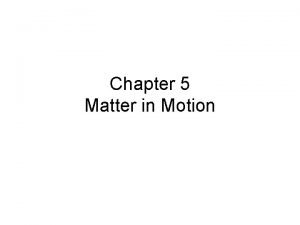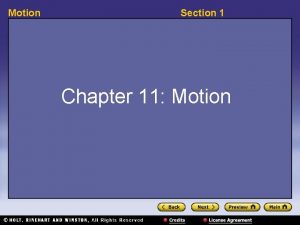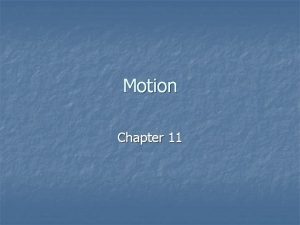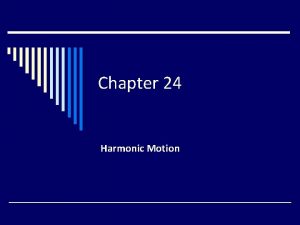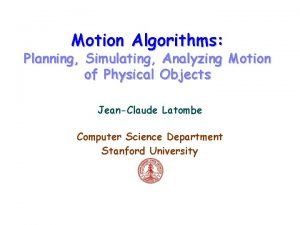Chapter 2 Kinematic Concepts for Analyzing Human Motion


























- Slides: 26

Chapter 2 Kinematic Concepts for Analyzing Human Motion © 2012 The Mc. Graw-Hill Companies, Inc. All rights reserved.

Forms of motion: Linear motion: motion along a line • Rectilinear motion: (along a straight line) • Curvilinear motion: (along a curved line) 2 -2

Forms of motion: Angular motion: rotation around an axis 2 -3

Forms of motion: Angular motion Curvilinear motion Rectilinear motion 2 -4

Forms of motion: General motion: a combination of linear and angular motion (includes most human motion) 2 -5

What is a mechanical system? • a body or portion of a body that is deliberately chosen by the analyst • examples: throwing arm, kicking leg, the trunk during performance of a lift, the entire body during performance of a maximal vertical jump 2 -6

What is anatomical reference position? • erect standing position with all body parts facing forward • considered the starting point for all body segment movements 2 -7

Directional terms: superficial: toward the surface of the body deep: inside the body away from the surface superior: closer to the head inferior: farther away from the head medial: toward the midline of the body lateral: away from the midline of the body anterior: toward the front of the body posterior: toward the back of the body distal: away from the trunk proximal: closer to the trunk 2 -8

Directional terms superficial: toward the surface of the body deep: inside the body away from the surface Your ribcage is superficial to your heart, but deep to your pectoral muscles.

Directional terms The nose is superior to the mouth. The umbilicus is inferior to the sternum Naval (clinically known as umbilicus)

Directional terms Medial: toward the midline of the body The chest is medial to the arm. Lateral: away from the midline of the body The ears are lateral to the nose

Directional terms anterior: toward the front of the body posterior: toward the back of the body The heart is posterior to the sternum

Directional terms “The wrist is proximal to the hand” Proximal and distal don't compare the wrist to the hand, compare the [wrist to the torso] vs [the hand to torso]. The wrist is in closer proximity to where the limb attaches to the torso than the wrist is. Torso Wrist Hand

Reference planes: • sagittal plane - in which forward and backward movements occur • frontal plane - in which lateral movements occur • transverse plane - in which rotational movements occur 2 -14

Reference axes: Longitudinal axis - directed vertically and around which rotational movements occur Anteroposterior axis – directed along the sagittal plane and around which rotations in the frontal plane occur Mediolateral axis – directed along the frontal plane and around which rotations in the sagittal plane occur 2 -15

What movements occur in the sagittal plane? Flexion Extension Dorsiflexion Hyperextension Plantar flexion 2 -16

What movements occur in the sagittal plane? Elbow Hip Shoulder Head Knee

What movements occur in the frontal plane? Radial deviation Abduction Ulnar deviation Adduction Lateral flexion Elevation Depression Eversion Inversion 2 -18

What movements occur in the transverse plane? Horizontal adduction Medial rotation Lateral rotation Pronation Supination Horizontal abduction 2 -19

Spatial Reference Systems • useful for standardizing descriptions of human motion • most commonly used is the Cartesian coordinate system • human body joint centers are labeled with numerical x and y coordinates 2 -20

Spatial Reference Systems Y (x, y) = (3, 7) (0, 0) X Cartesian coordinates of the hip 2 -21

Spatial Reference Systems y x=y=+ x=+ y=+ x (0, 0) x=y=- x=+ y=- Coordinates can be both positive and negative. 2 -22

Qualitative Analysis: Prerequisite Knowledge • What is the purpose of the skill? • What are the causes of performance errors? • How can knowledge be gained? • experience in performing the skill • reading available literature • attending conferences and workshops 2 -23

Qualitative Analysis: Planning • What is the question to be answered? • From what perspectives (angle and viewing distance) should the movement be viewed? • How many observations should be taken? 2 -24

Qualitative Analysis: Planning • What plans should be made for: • performer attire • lighting conditions • background • use of video 2 -25

Qualitative Analysis: Conducting the Analysis Identify Question/Problem Viewing Angle Viewing Distance Performer Attire Refine Question Make Decisions Use of Video End Analysis Communicate with Performer Environmental Modifications Collect Observations Visual Auditory From Performer Interpret Observations From Other Analysts 2 -26
 Track manager
Track manager Chapter 2 analyzing transactions answer key
Chapter 2 analyzing transactions answer key Kinematic equations for uniformly accelerated motion
Kinematic equations for uniformly accelerated motion Linear kinematic equations
Linear kinematic equations Kinematic equations for circular motion
Kinematic equations for circular motion It is a motion along a straight line
It is a motion along a straight line Projectile motion formula
Projectile motion formula 3 kinematic equations
3 kinematic equations Chapter 2 motion section 1 describing motion answer key
Chapter 2 motion section 1 describing motion answer key What is acceleration
What is acceleration Chapter 2 motion section 1 describing motion answer key
Chapter 2 motion section 1 describing motion answer key Aristotelian and galilean concepts of motion
Aristotelian and galilean concepts of motion Aristotelian and galilean concepts of motion
Aristotelian and galilean concepts of motion Human needs and human development
Human needs and human development Chapter 8 human needs and human development
Chapter 8 human needs and human development Timeless kinematic equation
Timeless kinematic equation Timeless kinematic equation
Timeless kinematic equation Big 4 equations
Big 4 equations Luke autbeloe drops a pile of roof shingles
Luke autbeloe drops a pile of roof shingles Constant acceleration equations
Constant acceleration equations Pre kinematic texture
Pre kinematic texture Kinematic equatiobs
Kinematic equatiobs Third kinematic equation
Third kinematic equation Kinematics symbols
Kinematics symbols Big 5 kinematic equations
Big 5 kinematic equations X軸 y軸 z軸
X軸 y軸 z軸 Specific weight symbol
Specific weight symbol
